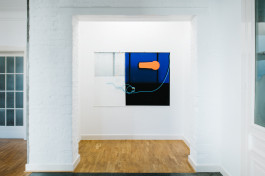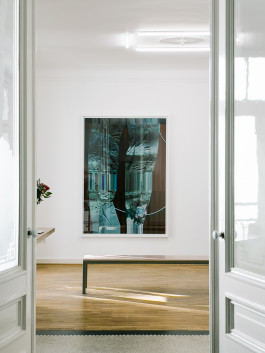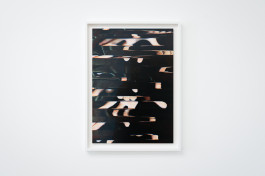Victoria Pidust
Bildmassage
30.10.21–30.12.21
Installation view



Victoria Pidust,
Untitled 3
Victoria Pidust,
Untitled 4
Victoria Pidust,
Untitled 10
“For me, photography means capturing reality like a paint brush captures colour”
With her many-layered panoramas, Victoria Pidust spirits us away into a visual maze, where our perception becomes stirred up – a provocation to the way we perceive works produced with photographic techniques.
Pidust combines photography and painting by transferring the genre of photography from something that depicts reality to an intrinsically creative medium for presenting modulations of reality. She prepares her work using characteristic photography materials: light, generative processes and equipment – which does not necessarily have to include cameras –, as well as imaging processes from disciplines outside the field. In her pictures, the artist brings together real, abstract and concrete forms of representation. The components of her montages are only partly produced with photographic cameras. In her artistic practise, she applies and mixes a variety of the imaging techniques available: analogue and digital photos, as well as 3D renderings produced by computer programs for architectural models.
The artist’s images are made up of analogue elements (photographed by Pidust herself) and digital components, where the artist uses 3D programs or allows them to work for her. For example, Pidust works with a creative software for scanning architecture and for producing digital models of rooms and spaces, by interfering with the program-immanent algorithms that are responsible for the so-called pattern recognition. This gives rise to something new and unexpected, the process of creativity has become independent. The computer becomes a creative entity, because she uses artificial intelligence to manipulate true-to-life representations. Chance becomes a central element in the process.
With her hybrids, as Pidust calls her pieces, the artist uses contemporary means to further write in the chapter on generative photography. In her baroque-like work, she brings together a number of supposedly irreconcilable procedures: the images are both analogue and digital, and unite subjective and generative photography. They are produced through human consciousness and artificial intelligence, and they describe the path from 2D to 3D and from 3D to 2D. Behind her aesthetic concept is the idea of mirroring our world with other perceptions. As often as not, looking at the opulent panoramas ends up with an examination of what is “real” in a picture produced with photographic techniques. Pidust’s work not only represents a shift in reality on the visual level, but also pushes the viewer to reflect on traditional patterns of perception, right into philosophical dimensions.
Carla Susanne Erdmann
Victoria Pidust
Bildmassage
30.10.21–30.12.21
Installation view

Victoria Pidust, Untitled 3

Victoria Pidust, Untitled 4

Victoria Pidust, Untitled 10
“For me, photography means capturing reality like a paint brush captures colour”
With her many-layered panoramas, Victoria Pidust spirits us away into a visual maze, where our perception becomes stirred up – a provocation to the way we perceive works produced with photographic techniques.
Pidust combines photography and painting by transferring the genre of photography from something that depicts reality to an intrinsically creative medium for presenting modulations of reality. She prepares her work using characteristic photography materials: light, generative processes and equipment – which does not necessarily have to include cameras –, as well as imaging processes from disciplines outside the field. In her pictures, the artist brings together real, abstract and concrete forms of representation. The components of her montages are only partly produced with photographic cameras. In her artistic practise, she applies and mixes a variety of the imaging techniques available: analogue and digital photos, as well as 3D renderings produced by computer programs for architectural models.
The artist’s images are made up of analogue elements (photographed by Pidust herself) and digital components, where the artist uses 3D programs or allows them to work for her. For example, Pidust works with a creative software for scanning architecture and for producing digital models of rooms and spaces, by interfering with the program-immanent algorithms that are responsible for the so-called pattern recognition. This gives rise to something new and unexpected, the process of creativity has become independent. The computer becomes a creative entity, because she uses artificial intelligence to manipulate true-to-life representations. Chance becomes a central element in the process.
With her hybrids, as Pidust calls her pieces, the artist uses contemporary means to further write in the chapter on generative photography. In her baroque-like work, she brings together a number of supposedly irreconcilable procedures: the images are both analogue and digital, and unite subjective and generative photography. They are produced through human consciousness and artificial intelligence, and they describe the path from 2D to 3D and from 3D to 2D. Behind her aesthetic concept is the idea of mirroring our world with other perceptions. As often as not, looking at the opulent panoramas ends up with an examination of what is “real” in a picture produced with photographic techniques. Pidust’s work not only represents a shift in reality on the visual level, but also pushes the viewer to reflect on traditional patterns of perception, right into philosophical dimensions.
Carla Susanne Erdmann
Get in contact or
book an appointment
Schirmerstrasse 61
Backyard
40211 Duesseldorf
Germany
Follow us on Instagram, or subscribe to our newsletter to receive invitations to upcoming exhibition openings and more information about featured artists.
Get in contact or
book an appointment
Schirmerstrasse 61
Backyard
40211 Duesseldorf
Germany
Follow us on Instagram, or subscribe to our newsletter to receive invitations to upcoming exhibition openings and more information about featured artists.